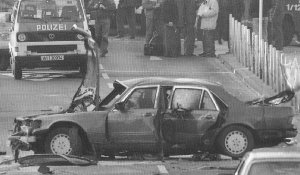January 6, 2017
In our previous post regarding a potential new modus operandi used by some terrorists, we mentioned the possibility that terror groups may now be developing hardened, professional cadres of assassins, rather than using suicide bombers or recruiting martyrs. We noted the similarity in this tactic with terror groups from the 1970s and 80s, including the Red Army Faction (RAF). In response to several queries, we received about the tactics used by the RAF we have decided to post an analysis of an assassination carried out by the RAF in Germany in 1989.
 On 30 November 1989, in Bad Homburg (a small suburb of Frankfurt, Germany), a group of RAF operatives carried out the assassination of Alfred Herrhausen, Chairman of the Deutsche Bank. Herrhausen was on his way to work and about a half-mile from his home when a remote-controlled improvised explosive device was detonated next to his armored Mercedes Benz limousine. Herrhausen’s vehicle was the second in a line of three vehicles protective convoy. After the first vehicle, carrying members of his executive protection team, passed the hidden IED, a concealed member of the RAF triggered an infrared beam that, when disrupted by Herrhausen’s limo, detonated 50lbs of TNT, launching a five-pound copper shaped-charge plate through Herrhausen’s door on the vehicle, killing him and injuring his driver. The RAF operative then placed a note next to the remote trigger claiming responsibility for the attack in the name of fallen RAF “commando” Wolfgang Beer and walked to a waiting escape vehicle.
On 30 November 1989, in Bad Homburg (a small suburb of Frankfurt, Germany), a group of RAF operatives carried out the assassination of Alfred Herrhausen, Chairman of the Deutsche Bank. Herrhausen was on his way to work and about a half-mile from his home when a remote-controlled improvised explosive device was detonated next to his armored Mercedes Benz limousine. Herrhausen’s vehicle was the second in a line of three vehicles protective convoy. After the first vehicle, carrying members of his executive protection team, passed the hidden IED, a concealed member of the RAF triggered an infrared beam that, when disrupted by Herrhausen’s limo, detonated 50lbs of TNT, launching a five-pound copper shaped-charge plate through Herrhausen’s door on the vehicle, killing him and injuring his driver. The RAF operative then placed a note next to the remote trigger claiming responsibility for the attack in the name of fallen RAF “commando” Wolfgang Beer and walked to a waiting escape vehicle.
The preparation that went into this attack is a textbook example of the time and attention our adversaries will give to planning these types of operations. The IED was actually hidden inside a child’s backpack and attached to the luggage rack of a bicycle that was parked on the road leading from Herrhausen’s villa. The RAF had parked the bike there for several weeks ahead of the assassination, causing local residents to no longer notice the bike’s presence. The detonation site was carefully chosen, as it lay near a school crossing and bus stop, which forced vehicular traffic to slow down at this point. . A few days before the attack, RAF operatives, dressed as construction workers, dug a small trench from the road to a grove of trees and laid the control wire for the infrared beam. Amazingly, this wire was actually discovered by a real construction crew and removed. Undaunted, the RAF team returned and buried a new wire.
On the day of the assassination, no less than three RAF operatives were at the attack site. Two men, dressed in jogging suits (common apparel in this park at that time of day), were deployed as spotter and trigger man. The spotter waited until the lead vehicle had cleared the bicycle and then radioed the second operative, who triggered the infrared beam from the grove of trees. The RAF surveillance teams had measured the distance between the beam and the bicycle perfectly so that the IED was directly beside Herrhausen’s seat in the vehicle when the front bumper broke the beam. The resulting explosion threw the two-ton vehicle more than 50 feet across the road, killing Herrhausen, but no one else.
In the post-blast investigation, German police and intelligence officers learned that several local residents had noticed “unusual activity” around the attack site, but failed to report anything. This type of complacency is exactly what terrorists and other criminal groups seek to exploit. Staying “left of the problem” should be an integral part of any real security program, and this starts with educating your personnel and security professionals in threat detection and providing them the tools necessary to accurately capture and analyze suspicious behavior.
